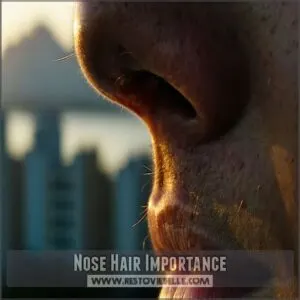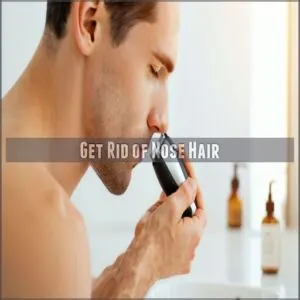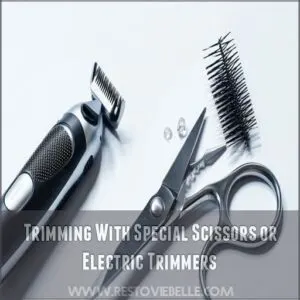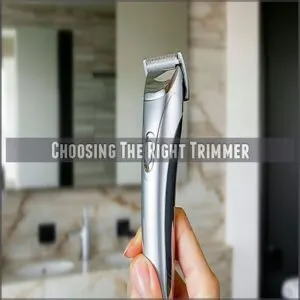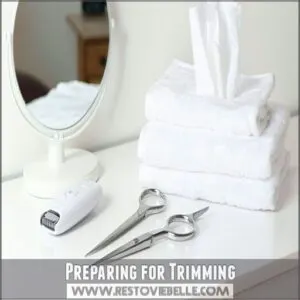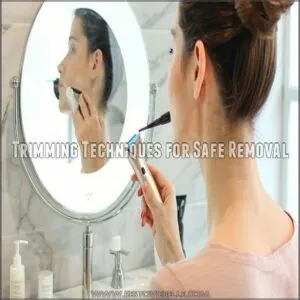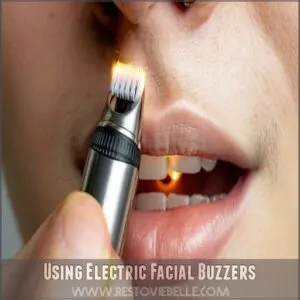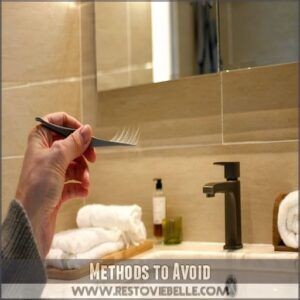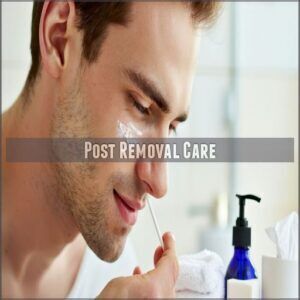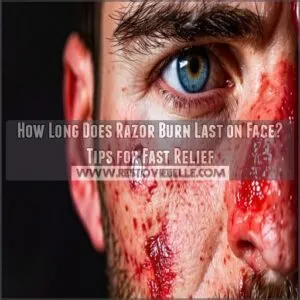This site is supported by our readers. We may earn a commission, at no cost to you, if you purchase through links.
 If you’re wondering how to get rid of nose hair without turning your nostrils into a danger zone, grab a pair of rounded-tip scissors or an electric trimmer specifically for nose hair.
If you’re wondering how to get rid of nose hair without turning your nostrils into a danger zone, grab a pair of rounded-tip scissors or an electric trimmer specifically for nose hair.
These tools keep things safe and painless while tidying up stray hairs that might venture too far.
Avoid waxing or plucking—sure, it sounds thorough, but it risks infections, ingrown hairs, and, honestly, is just plain painful.
Trim in a well-lit area (a magnifying mirror is your buddy here) and clean your tools before and after use.
Want a more permanent solution? Laser hair removal exists, but it’s pricey.
Table Of Contents
- Key Takeaways
- Nose Hair Importance
- Get Rid of Nose Hair
- Trimming Nose Hair
- Safe Removal Methods
- Risks of Nose Hair Removal
- Methods to Avoid
- Managing Ingrown Hairs
- Long Term Effects
- Post Removal Care
- Frequently Asked Questions (FAQs)
- How do you get rid of nose hair?
- What are the other ways to remove nose hair?
- How can I get rid of a stuffy nose?
- How do I trim my nose hair?
- What is the best way to remove nose hair?
- How can I stop hair from growing in my nose?
- Is it OK to remove nose hair?
- How do girls remove nose hair?
- Is it okay to pluck nose hairs?
- Why do I have so much hair inside my nose?
- Conclusion
Key Takeaways
- You can safely trim visible nose hairs with rounded-tip scissors or an electric trimmer. Avoid waxing or plucking as these methods increase your risk of infection and ingrown hairs.
- Nose hairs are essential for filtering out dust, allergens, and germs, so don’t over-trim. Excessive removal can compromise nasal function and increase your risk of respiratory infections.
- For ingrown hairs, stop hair removal and gently cleanse the area. You can carefully lift the hair out with a sterile needle but seek medical attention for any signs of infection.
- Maintain good nasal hygiene after trimming by cleaning your nostrils regularly with saline spray and avoiding picking your nose. Monitor for signs of complications like persistent redness, swelling, or unusual pain.
Nose Hair Importance
You might be tempted to yank out those pesky nose hairs, but hold on! They’re actually your tiny, hairy bodyguards, protecting you from all sorts of airborne invaders.
Functions of Nose Hair
Ever wonder about those pesky nose hairs? They’re your personal air filtration system!
These tiny gatekeepers trap dust and debris, preventing them from reaching your delicate nasal cavity.
This protective function contributes to nasal balance, boosting your respiratory health and supporting your immune system.
Your nose hairs and mucus production work together, maintaining a healthy, happy nasal cavity.
Benefits for Allergy and Asthma Sufferers
Want healthier breathing? Your nose hairs are tiny heroes, trapping allergens like pollen and dust before they wreak havoc on your airways.
This natural barrier reduces allergy symptoms, asthma attacks, and the misery of allergic rhinitis.
Keeping your nose hairs intact contributes to nasal balance and overall respiratory health. Smart nose hair management means fewer allergy woes and easier breathing.
Nasal Hair Growth and Blood Vessels
Behind nose hair growth lies a superstar: nasal blood flow. Those delicate vessels nourish each nose hair follicle, keeping your nasal tissue healthy. Here’s why it matters: Research on blood vessel growth shows its importance in hair growth.
- Blood circulation supports hair growth.
- Vessels warm and moisten incoming air.
- Strong vessel health defends against dryness and nosebleeds.
- Balanced blood flow keeps your nasal cavity primed for filtering allergens and debris.
Get Rid of Nose Hair
Dealing with pesky nose hairs? No shame—everyone does. The key is smart nose hair care that prioritizes nasal health.
Here’s how to safely get rid of nose hair:
- Use a nose hair trimmer with rounded tips for safe trimming.
- Stick to trimming only visible hairs—you’re not landscaping a jungle.
- Avoid risky methods like waxing or plucking—they’re painful and risky.
- Clean all tools before and after use to dodge infections.
For excessive growth, consider consulting a pro for advanced hair removal methods.
Keep it simple, keep it safe!
Trimming Nose Hair
Trimming your nose hair is a quick and safe way to keep things tidy without removing too much.
With the right tools and a bit of care, you can easily handle those pesky hairs sticking out.
Trimming With Special Scissors or Electric Trimmers
Tired of unruly strands peeking out? Trim nose hair safely with nose hair scissors or an electric nose hair trimmer.
Scissors offer precise control—think of them as the artist’s brush for detail work. Electric nose hair trimmers, on the other hand, bring speed and ease, especially for overall grooming.
For the best results, consider using nose hair scissors that are specifically designed for this task.
Always practice Electric Trimmer Safety by following the nostril’s natural curve. Keep tools clean! Rinse scissors or trimmer blades after each use to avoid irritation. No stress—your nostrils will thank you.
Choosing The Right Trimmer
A great nose hair trimmer isn’t your average gadget—it’s your grooming sidekick. Choose one that fits comfortably, trims precisely, and keeps nicks at bay.
Here’s what to look for in the best nose hair trimmer: When selecting a trimmer, consider the features of a nose hair trimmer.
- Ergonomic grip for easy handling.
- Blade safety with rounded edges.
- Electric nose hair trimmer for smooth cuts.
- Washable design for quick cleanup.
Preparing for Trimming
Before trimming nose hair, set up properly. Use sanitary tools like nose hair trimming scissors or electric trimmers, and make certain they’re squeaky clean. Bright lighting and a mirror are must-haves.
Keep tissues nearby to catch stray hairs. Understanding nose anatomy and hair growth patterns makes it easier to spot trouble areas. A clean workspace equals hassle-free trimming!
| Tool | Purpose | Key Feature |
|---|---|---|
| Nose Hair Trimmer | For trimming | Compact and precise |
| Scissors | Detailed cutting | Rounded tips |
| Tissues | Clean-up | Disposable |
| Mirror | Visibility | Magnifying option |
| Clean Towel | Workspace prep | Reusable |
Trimming Techniques for Safe Removal
When trimming nose hair, safety and precision are key. Follow these steps for hassle-free nose hair clipping:
- Tilt your head back under bright light.
- Gently insert a nose hair trimmer near the nostril entrance, moving in a slow, circular motion.
- Use a magnifying mirror for accuracy.
- Clean the trimmer thoroughly afterward to maintain nasal hygiene and prevent bacteria buildup.
Safe Removal Methods
Regarding safely getting rid of pesky nose hairs, you’ve got plenty of effective options that don’t involve unnecessary pain or drama.
From electric trimmers to professional laser treatments, you can tackle the job without compromising your nasal health.
Using Electric Facial Buzzers
Got unruly nose hairs? Electric nose trimmers are your trusty sidekick for clean, hassle-free trims. Choose one with rounded tips for comfort and safety (check those Electric Trimmer Reviews).
Gently buzz in slow, circular motions—don’t go too deep! Nose Hair Maintenance is key, and it’s fast and painless.
Remember, hygiene matters—clean your trimmer after every use. Say goodbye to wild hairs and hello to crisp Nose Hair Maintenance with the help of Electric Trimmer Reviews!
Professional Laser Hair Removal
Looking for painless nose hair removal that lasts? Laser hair removal is a safe nose hair removal option performed by pros.
With precise lasers targeting follicles, multiple treatment sessions address hair regrowth effectively. Costs vary, but the results are worth it—smooth nostrils without constant upkeep.
Minor skin reactions like redness or itching fade quickly, making this a game-changer for nose hair removal.
Maintaining Nasal Health After Removal
Beyond professional treatments, maintaining nasal balance after nose hair removal is key.
Treat your nasal passages like VIPs: gentle saline rinses, hands off! Watch for infection signs—redness or extra mucus production.
Prioritize your respiratory health and sinus care; clean air quality is your new best friend. This keeps those airways clear and infection-free, maximizing your nose hair health post-removal.
Risks of Nose Hair Removal
Removing nose hair might seem harmless, but it comes with some surprising risks that can affect your health.
From painful ingrown hairs to infections that make you regret ever reaching for those tweezers, it’s important to know what could go wrong, especially the potential for infections.
Pain and Ingrown Hairs
Nose hair removal shouldn’t turn into a tale of regret. Ingrown hairs? They’re like that unwanted guest who sticks around too long.
Here’s your smoother grooming strategy:
- Know the causes: Hair follicle issues, like wrong trimming angles, lead to ingrown hairs.
- Fight redness: A warm, wet cloth soothes redness and swelling.
- Skip plucking: Nose hair plucking opens doors to infections.
- Trim smartly: Use clean tools and avoid cutting too close.
Your nose deserves care, not chaos!
Damaged Mucous Membranes and Increased Infection Risk
Yanking out nose hairs might feel liberating at first, but it’s a slippery slope to trouble.
Damaged mucous membranes can leave you exposed to sinusitis, nasal vestibulitis, and even a respiratory infection.
Without that protective barrier, germs waltz right in, putting your airway protection and sinus health at risk.
Keep trimming safe, because repairing mucous membranes isn’t easy, and no one wants an unexpected infection to ruin their day.
Excessive Removal and Its Consequences
Overdoing it with nose hair removal can leave your body’s natural defenses feeling like they’ve thrown in the towel. Excessive trimming or plucking puts you at risk of nose hair damage and leads to troubling health consequences. Understanding oily skin causes can also help you address related issues that may arise from improper nose hair removal techniques.
Here’s the fallout from excessive nose hair removal:
- Higher chances of nasal infections (hello, bacteria!).
- Exposure to more allergens and airborne debris.
- Increased risk of respiratory issues and health risks.
- Permanent disruption of your nose’s natural filtration system.
Keep some hair—it’s there for a reason!
Methods to Avoid
Not all nose hair removal methods are created equal, and some can do more harm than good.
Before grabbing wax or experimenting with hair removal creams, it’s worth knowing why these options can backfire in painful and risky ways.
Dangers of Waxing or Plucking
Pulling nose hairs might seem quick, but it’s a fast track to nose infection risk and hair follicle damage. Plucking dangers include painful ingrown hairs, while nose hair waxing can cause unbearable nasal irritation or inflammation.
These waxing complications aren’t just uncomfortable—they invite bacteria, increasing the risks of nose hair removal. Instead of suffering through bleeding or follicle trauma, follow safer nose hair removal tips.
Your nose is a filter, not a battlefield—treat it kindly!
Risks of Depilatory Creams
Hair removal creams might look like a quick fix, but trust me, they’re no friend to your nose.
Their harsh chemicals can wreak havoc:
- Chemical burns, leaving you uncomfortable for days.
- Skin irritation, since delicate nasal tissue isn’t ready for those formulas.
- Allergic reactions, bringing itching and redness you don’t need.
Cream misuse could even lead to nasal damage. Stick with safer nose hair removal tips to avoid these cringe-worthy side effects!
Potential Damage From Laser Treatment
Laser hair removal for nose hair might sound tempting, but it’s a minefield of treatment risks. From laser burns and skin irritation to uneven hair regrowth, these side effects can leave lasting trouble.
The nostril’s delicate tissue is prone to facial damage, swelling, and even scarring.
Here’s a quick snapshot:
| Risk | Cause | Outcome |
|---|---|---|
| Laser Burns | Overexposure to heat | Pain/Redness |
| Skin Irritation | Sensitive tissue reaction | Discomfort |
| Hair Regrowth | Follicle damage | Uneven regrowth |
Managing Ingrown Hairs
Ingrown nose hairs can be annoying and even a little painful, but they’re usually easy to handle with the right approach.
By keeping the area clean and using simple tools like a sterile needle, you can fix the problem without making it worse.
Stopping Hair Removal and Cleaning The Area
Got an ingrown hair? Hit pause on any hair removal attempts to avoid making things worse.
Stick to gentle cleansing with antibacterial soap, followed by a warm compress to ease irritation—it’s like a mini spa for your nose!
Prioritize nasal hygiene by using a nasal spray or antiseptic to keep things clean.
Stay consistent with your aftercare routine to prevent infection.
Using a Sterile Needle to Lift Out Ingrown Hairs
Dealing with ingrown hairs after nose hair removal? Use Sterile Needle Techniques for a safe fix. Clean a needle with alcohol, then soften the skin using a warm compress. Carefully slip the needle under the hair to lift it—be precise, no treasure hunts here!
For Ingrown Hair Prevention, wash the area and apply antibiotic ointment after removal. These Needle Safety Tips can save you from infections and keep your nose hair game in check!
Seeking Medical Attention for Infections
If you notice signs of an infection like redness, swelling, or pus, it’s time to let a doctor step in. A nose hair infection isn’t worth the risk!
Here’s how doctors help:
- Antibiotics: Fight off bacterial infections fast.
- Drainage: For stubborn or severe cases.
- Prevention Tips: To avoid sinusitis or respiratory infection.
Don’t ignore these warning signs—your nose deserves some TLC and professional care.
Long Term Effects
Removing nose hair might seem harmless, but it can impact how well your nose filters air and traps allergens over time.
If you go overboard, you might leave your nasal passages defenseless, which isn’t exactly the outcome you’d hope for.
Impact on Nasal Function and Health
Overdoing nose hair removal messes with your nasal balance, leaving your airways and mucous production defenseless.
Without this natural filter, your nose turns into an open door for respiratory infections, sinusitis, and other sinus problems.
Think of nasal hair as bouncers protecting your lungs from lousy air quality.
Proper razor burn treatment is also essential for maintaining healthy skin after shaving other areas of the face. Trim with care—nobody wants their "guardian" out on permanent vacation leading to health struggles!
Potential Risks and Consequences
Don’t underestimate the risks of over-trimming nose hair—your tiny bodyguards play a big role! Yank out too much, and you’re basically inviting nasal infections, sinus issues, and even respiratory problems.
Why? Because without enough of those hairs, debris and bacteria march right in. Damaged hair follicles? Expect painful irritation and ingrown hairs.
- Ingrown hairs: Painful bumps that itch or get infected.
- Hair regrowth troubles: Weakened follicles mean patchy, uneven regrowth.
- Sinus issues: Dryness makes your nose feel like a desert.
- Allergic reactions: With fewer barriers, allergens slip through easily.
Alternative Methods for Reducing Nose Hair
Looking for gentle nose hair management? Try natural remedies like peppermint or tea tree oil. While they won’t magically erase hairs, they can soften growth (follicle minimization, anyone?).
For home nose hair removal, manual trimmers offer a quick, safe fix—cheap, portable, and easy to use. Skip waxing or plucking unless you enjoy ingrown hairs or irritation.
Embrace these easy nose hair removal methods for stress-free grooming!
Post Removal Care
Taking care of your nose after trimming isn’t just about staying tidy—it’s about avoiding pesky infections too.
Make sure to clean your nostrils and tools properly, and keep an eye out for any redness or irritation.
Daily Precautions to Prevent Infection
Keeping your nose germ-free after trimming isn’t rocket science—it’s all about smart habits.
Always wash your hands before touching your nose, because let’s face it, bacteria love a careless moment.
Add nasal sanitizing to your daily routines using a mild antiseptic wipe.
Skip the nose-picking marathon and focus on personal hygiene, especially around the nostrils.
These infection control steps keep your nasal passage clean, prevent infections, and guarantee your health and safety stay intact.
Keeping The Nasal Passage Clean
Think of your nostrils as tiny air filters—they need regular care to stay efficient.
Spray a little saline daily for exceptional nasal hygiene tips, keeping bacteria and germs at bay.
Using saline drops can be beneficial for maintaining nasal moisture.
Gently blow your nose to manage mucus and maintain sinus health without overdoing it.
Skip the urge to poke around—nostril cleaning is about balance, not excavation!
Monitoring for Signs of Complications
Notice anything odd after trimming? It might be time to check for infection signs or complication risks. Watch for redness, swelling, or ongoing pain—those could signal nasal damage or a brewing medical issue.
Using hair removal methods can also help prevent future complications. Here’s what to look out for:
- Persistent irritation or unusual tenderness.
- Ingrown hairs causing visible bumps or discomfort.
- Significant swelling paired with redness or warmth.
- Funky drainage or fever—bacteria love causing chaos.
Symptom tracking keeps you one step ahead of health warnings. Stay cautious!
Frequently Asked Questions (FAQs)
How do you get rid of nose hair?
Your nose hairs are tiny guardians, but when they’re too bold, trim them with scissors or an electric trimmer.
Avoid plucking or waxing—trust me, it’s painful.
Stick to safe methods to stay irritation-free!
What are the other ways to remove nose hair?
You can try laser hair removal for a permanent fix (though pricey).
Opt for waxing if you dare to handle the pain, or use hair removal creams cautiously to avoid burning your nasal skin.
How can I get rid of a stuffy nose?
Steam it out with a hot shower or bowl of warm water and a towel over your head.
Stay hydrated, use saline spray, or try a decongestant.
Don’t forget: never underestimate spicy food!
How do I trim my nose hair?
Ever catch a glimpse of renegade nose hair in the mirror?
Grab some small, rounded-tip scissors or an electric trimmer. Use bright lighting, a mirror, and gentle hands.
Just snip the visible ones—don’t overdo it!
What is the best way to remove nose hair?
The best way to remove nose hair is by trimming with scissors or an electric trimmer.
It’s safe, simple, and avoids irritation.
Skip waxing or plucking—your nose deserves protection, not pain or infections!
How can I stop hair from growing in my nose?
Stopping nose hair growth completely is like trying to stop a river—it’s natural.
You can slow it with laser hair removal by a pro.
Otherwise, regular trimming keeps things tidy without compromising health.
Is it OK to remove nose hair?
Yes, it’s fine to trim nose hair for grooming, but leave enough for protection.
Trimming keeps things safe and tidy, while plucking or waxing can lead to infections—nobody wants that drama in their nostrils!
How do girls remove nose hair?
You can safely trim nose hair with small, blunt-tipped scissors or an electric trimmer.
Bright lighting and a mirror help.
Avoid waxing or plucking—it’s painful and risks infection.
Stick to trimming just the visible hairs!
Is it okay to pluck nose hairs?
Yanking those suckers out might seem tempting, but it’s a bad idea.
Plucking can cause ingrown hairs, infections, and even serious health risks.
Stick to trimming instead—it’s safer and keeps your nose happy and healthy.
Why do I have so much hair inside my nose?
It’s just genetics doing its thing.
Some folks naturally have more nose hair due to hormonal influences or ancestry.
Plus, nose hairs thrive because they’re essential—they’re nature’s tiny bodyguards against dust, allergens, and germs.
Conclusion
Think of nose hair like a bodyguard—it’s there for a reason, but a little cleanup can make things less wild.
Safe tools like rounded-tip scissors or trimmers are your best bet when figuring out how to get rid of nose hair. Skip risky methods like waxing or plucking and keep hygiene a priority.
Whether you’re trimming for comfort, appearance, or health, remember: a little maintenance is fine, but don’t overdo it. Your nose will thank you for a little maintenance!
- http://www.russakdermatology.com/
- https://www.romeojuliettelaserhairremoval.com/about-romeo-juliette-laser-hair-removal
- https://www.mayoclinic.org/diseases-conditions/ingrown-hair/symptoms-causes/syc-20373893
- https://www.aad.org/cosmetic/hair-removal/laser-hair-removal-overview
- https://www.karger.com/Article/Abstract/321912

